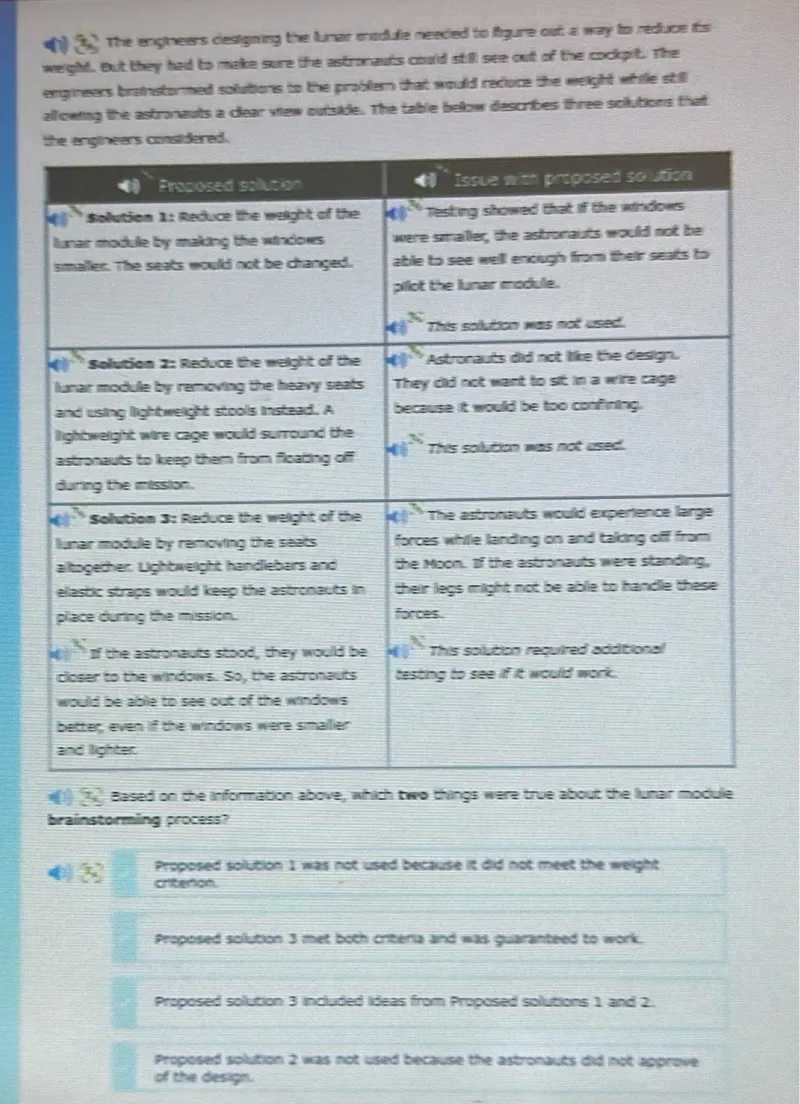Questions: The engineers designing the lunar module needed to figure out a way to reduce its weight, but they had to make sure the astronauts could still see out of the cockpit. The engineers brainstormed solutions to the problem that would reduce the weight while still allowing the astronauts a clear view outside. The table below describes three solutions that the engineers considered. Solution 1: Reduce the weight of the lunar module by making the windows smaller. The seats would not be changed. Solution 2: Reduce the weight of the lunar module by removing the heavy seats and using lightweight stools instead. A lightweight wire cage would surround the astronauts to keep them from floating off during the mission. Solution 3: Reduce the weight of the lunar module by removing the seats altogether. Lightweight handlebars and elastic straps would keep the astronauts in place during the mission. If the astronauts stood, they would be closer to the windows. So, the astronauts would be able to see out of the windows better, even if the windows were smaller and lighter. Testing showed that if the windows were smaller, the astronauts would not be able to see well enough from their seats to pilot the lunar module. This solution was not used. Astronauts did not like the design. They did not want to sit in a wire cage because it would be too confining. This solution was not used. The astronauts would experience large forces while landing on and taking off from the Moon. If the astronauts were standing, their legs might not be able to handle these forces. This solution required additional testing to see if it would work. Based on the information above, which two things were true about the lunar module brainstorming process? Proposed solution 1 was not used because it did not meet the weight criteria. Proposed solution 3 met both criteria and was guaranteed to work. Proposed solution 3 included ideas from Proposed solutions 1 and 2. Proposed solution 2 was not used because the astronauts did not approve of the design.

Transcript text: The engineers designing the lunar module needed to figure out a way to reduce its weight, but they had to make sure the astronauts could still see out of the cockpit. The engineers brainstormed solutions to the problem that would reduce the weight while still allowing the astronauts a clear view outside. The table below describes three solutions that the engineers considered.
Solution 1: Reduce the weight of the lunar module by making the windows smaller. The seats would not be changed.
Solution 2: Reduce the weight of the lunar module by removing the heavy seats and using lightweight stools instead. A lightweight wire cage would surround the astronauts to keep them from floating off during the mission.
Solution 3: Reduce the weight of the lunar module by removing the seats altogether. Lightweight handlebars and elastic straps would keep the astronauts in place during the mission.
If the astronauts stood, they would be closer to the windows. So, the astronauts would be able to see out of the windows better, even if the windows were smaller and lighter.
Testing showed that if the windows were smaller, the astronauts would not be able to see well enough from their seats to pilot the lunar module. This solution was not used.
Astronauts did not like the design. They did not want to sit in a wire cage because it would be too confining. This solution was not used.
The astronauts would experience large forces while landing on and taking off from the Moon. If the astronauts were standing, their legs might not be able to handle these forces. This solution required additional testing to see if it would work.
Based on the information above, which two things were true about the lunar module brainstorming process?
Proposed solution 1 was not used because it did not meet the weight criteria.
Proposed solution 3 met both criteria and was guaranteed to work.
Proposed solution 3 included ideas from Proposed solutions 1 and 2.
Proposed solution 2 was not used because the astronauts did not approve of the design.





